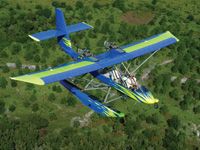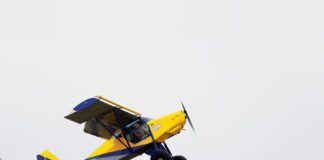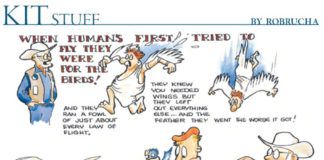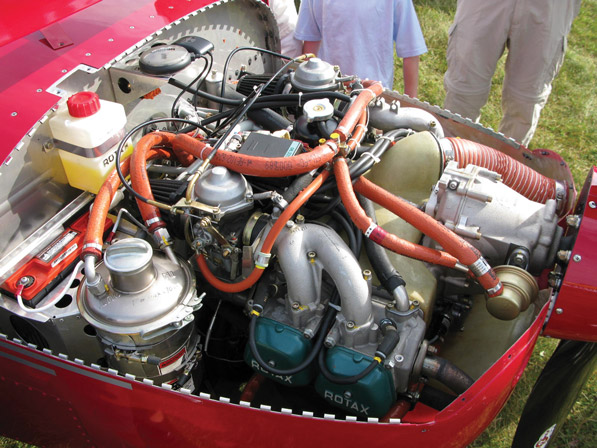
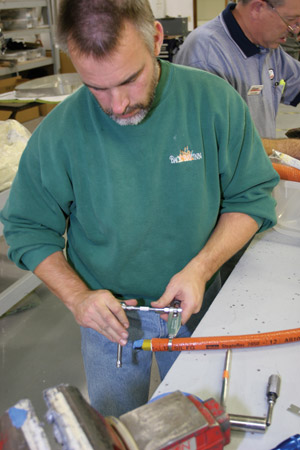
All right, Shakespeare probably hadn’t considered aircraft when he penned Macbeth, but as airplane builders there is at least one sleeve we want to knit up with care.
In the crowded spaces underneath the typical engine cowling, hoses carrying oil and fuel to the engine-liquids that must remain cool-are forced into proximity to exhaust systems, turbochargers, oil coolers and cylinders, all of which produce copious quantities of heat. There isn’t any practical way to cool these hoses, so the trick is to prevent them from absorbing heat and even more importantly, protect them from open flame should something go badly wrong in the engine compartment. The traditional answer is to cover the hoses in a flexible, insulating tube generically known as firesleeve.
Two kinds of firesleeve are commonly seen in homebuilt aircraft. The most common-because it has been around longer and is practical in a home workshop-is a simple tube of orange silicone-impregnated fabric lined with a layer of non-combustible fiberglass mat. It is usually slipped over the hoses just before they are installed.
The Installation
Installing this kind of firesleeve is a relatively easy job, but like almost everything on an airplane, it requires a tool and technique. Putting the sleeve over the hose is simple enough. Firesleeve can be purchased by the running foot in many different diameters. Most hoses in homebuilt airplanes are 3⁄8 inch in internal diameter (fuel hoses and oil hoses on small engines) or 1⁄2 inch (typically oil hoses on larger engines). Measure the diameter of the hose, select the appropriate firesleeve, use scissors to cut off a length that covers the hose from fitting to fitting, and slide it on.
To keep the overall diameter to a minimum, its possible to install the fitting on one end of the hose and use firesleeve just large enough to cover the hose portion before installing the fitting on the other end. If the firesleeve grips the outside surface of the hose so tightly its difficult to slide it along, compressed air will solve the problem. Use one hand to clamp the far end of the sleeve to the hose and insert an airgun between the sleeve and hose at the other end. When you pull the trigger, the trapped air will puff up flexible firesleeve and allow it to move as needed.
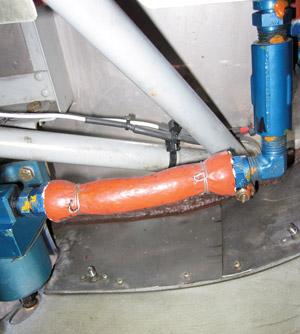
Once the sleeve is installed, it must be clamped to the hose with enough pressure to keep it from sliding around, but not enough to crush it and ruin its insulating properties. While this can be accomplished with a few delicately applied wraps of safety wire, the professionals use a simple tool to make a stainless-steel band clamp. The results are, well, more professional. The clamp looks better, applies even pressure for a better fit and leaves no nasty barbs to poke holes in the sleeve. Using the tool as directed assures a permanent, correctly installed sleeve, but scarred and knowing A&Ps strongly suggest buffing off the end of the stainless ribbon (where the tool cuts it to length) with a Scotch-Brite wheel to prevent unsightly bloodstains inside the cowl.
Once found only in professional shops, banding tools are now available to homebuilders. They aren’t cheap (the Pok-It II tool manufactured by Band-It-Idex, Inc. sells for about $115), considering that they are only used a dozen times or so on the typical homebuilt airplane. They will last for many years, though, and would be an excellent choice for a builders group tool bank where the expense could be amortized over time and multiple installations.
After the firesleeve is installed and banded, the exposed ends of fiberglass insulation must be protected. The crude but effective method is to smear orange high-temp silicone (available in squeeze tubes at any auto parts store) over the ends and let it cure. More professional-looking results come from dipping each hose end in a special fireproof dipping solution. With the right tools and materials, installing firesleeve takes just a few minutes and should protect the hose for its working life.
Type II
A second type of firesleeve has appeared in recent years. Its easy to identify-smooth and either brown or blue (though the color has no significance)-integral silicone firesleeve has several advantages as Randy Herber of Herber Aircraft Services (www.herberaircraft.com) pointed out during a quiet moment at AirVenture.
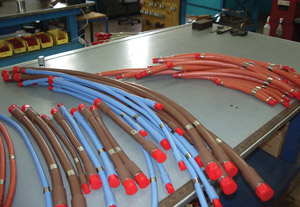
Integral firesleeve is bonded to the hose at the factory, he explained. When we make a custom hose, we cut the necessary length off a roll of bulk hose. The sleeve is always perfectly bonded to the outside of the hose; there are no voids or open spots. After the fittings are installed at either end, separated pieces of sleeve are installed over them and vulcanized permanently in place. The result is a hose that is protected from end to end. Its completely sealed, so there’s no way flame can penetrate to the hose itself.
Other advantages of the integral firesleeve include hoses that will bend to tighter radii without puckering or binding and have a significantly smaller outside diameter. As Herber explained, Those features can be especially important when engines are stuffed into small spaces like homebuilt cowls or nacelles on twins.
While it isn’t practical for homebuilders to fabricate and install comparable integral firesleeve hoses in typical workshops (vulcanizing the ends is tricky and requires a special press), it is easy and practical to order hoses from a shop like Herber’s. They will need to know the overall length of the hose, the diameter, the type of hose desired and the configuration of the fittings (Straight? Right angle? 45?) that is required. Custom hoses will cost more, but they arrive ready to install and professionally manufactured.
Whether you choose to order custom-made components or sleeve-and-dip your own, you will fly more safely and confidently knowing that the flammable liquids moving through the engine compartment are well protected.











